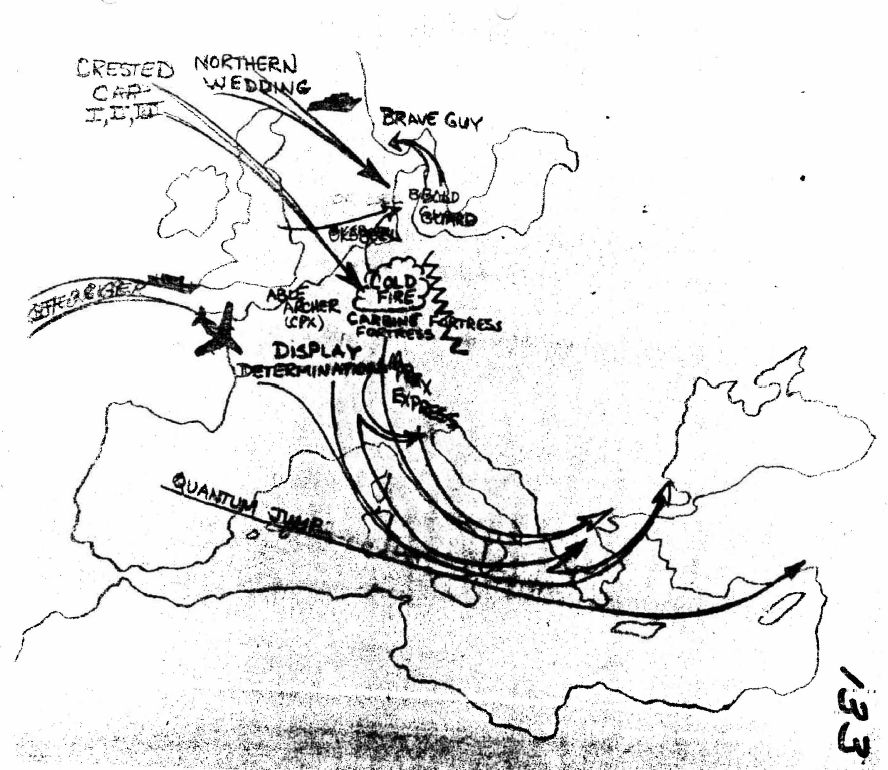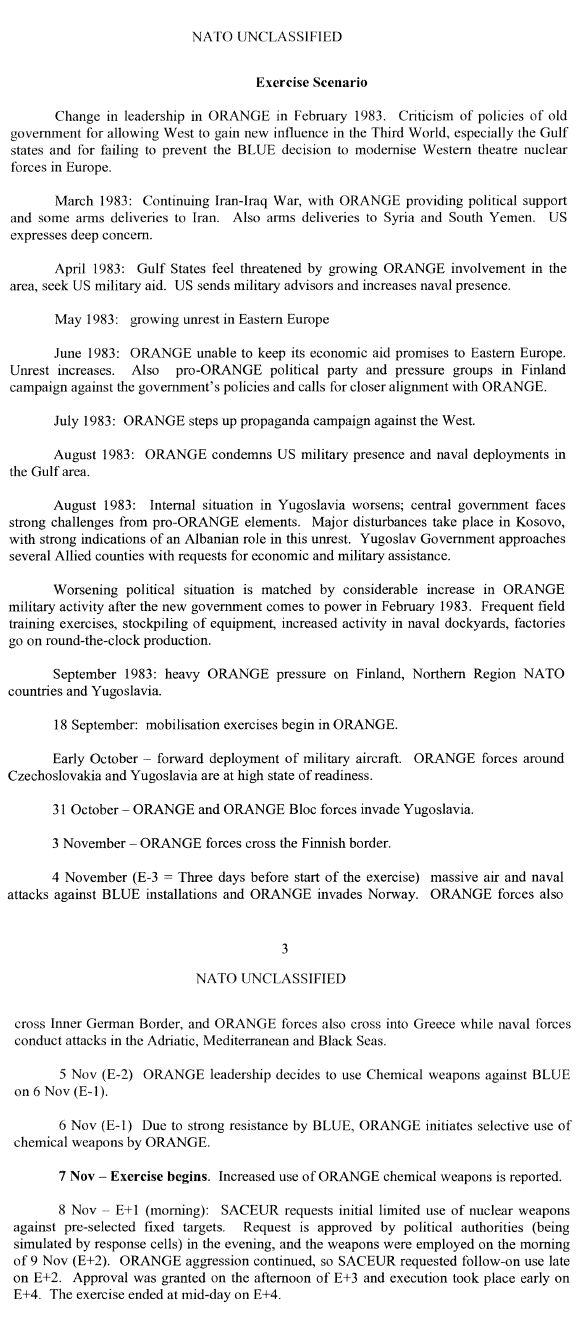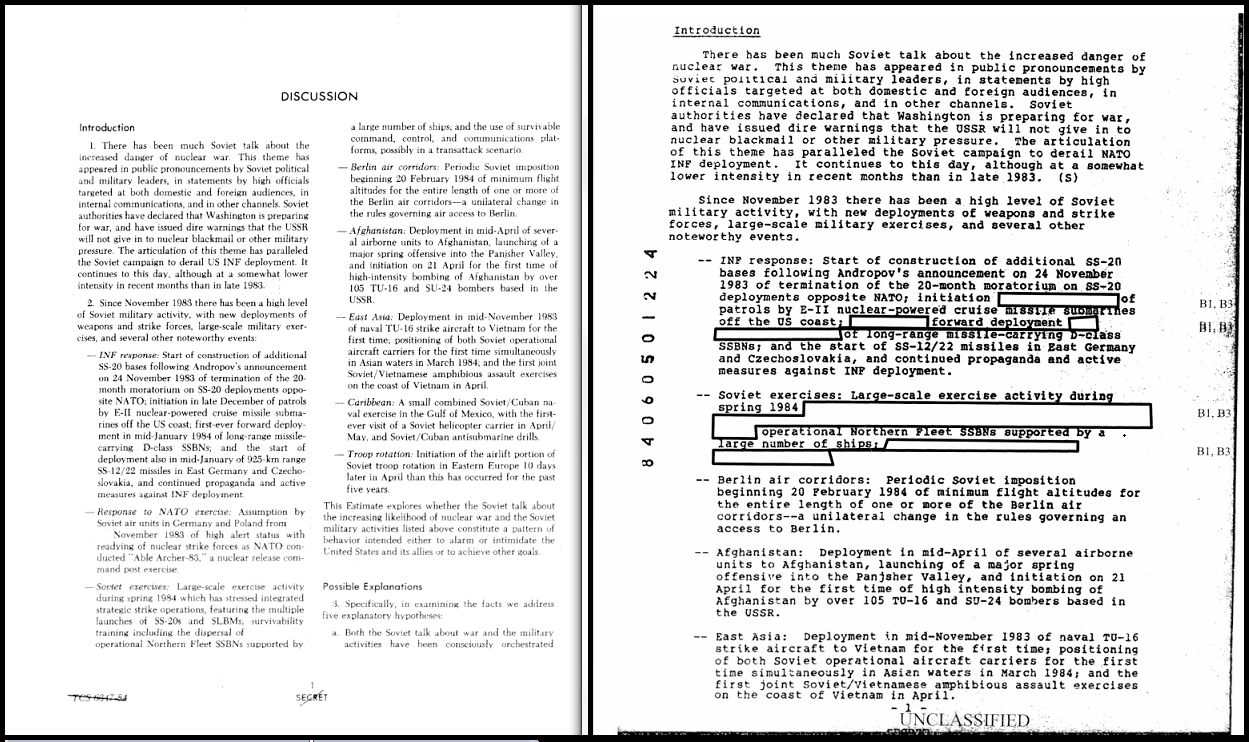Nuclear War Scare: NATO’s “Nuclear Weapons Release Procedures”
The Able Archer 83 Sourcebook

Today (November 7) marks the 30th anniversary of the beginning of Able Archer 83, a NATO exercise that utilized “new nuclear weapons release procedures” to simulate the transition from conventional to nuclear war with the Soviet Union.
Although US officials saw Able Archer 83 as a routine exercise, it resulted in an “unprecedented Soviet reaction” which US intelligence eventually inferred “was an expression of a genuine belief on the part of Soviet leaders that US was planning a nuclear first strike,” according to the largest collection of declassified documents on the 1983 War Scare compiled and posted by the National Security Archive, www.nsarchive.org.
 The climax of Able Archer 83 was on November 9, 1983 when NATO war gamers at Supreme Headquarters Allied Power Europe (SHAPE) realized they could not halt a simulated Soviet conventional advance and requested “initial limited use of nuclear weapons against pre-selected fixed targets.” This limited strike was not enough, and on the morning of November 11, a “follow-on use of nuclear weapons was executed.”
The climax of Able Archer 83 was on November 9, 1983 when NATO war gamers at Supreme Headquarters Allied Power Europe (SHAPE) realized they could not halt a simulated Soviet conventional advance and requested “initial limited use of nuclear weapons against pre-selected fixed targets.” This limited strike was not enough, and on the morning of November 11, a “follow-on use of nuclear weapons was executed.”
While NATO was practicing a drawn-out transition from conventional to nuclear war, Soviet leadership feared a decapitating first strike. The imminent European deployment of western Pershing II and cruise missiles which could reach the Soviet Union in ten minutes led Soviet General Secretary Yuri Andropov to warn in June of 1983 of the “the dangerous ‘red line'” of nuclear war through “miscalculation” four times during his “first real meeting” with an envoy from the Reagan administration. A KGB report from May of 1982 describes the creation of the largest peace-time human intelligence gathering operation in history, Operation RYaN, in an attempt to “prevent the possible sudden outbreak of war by the enemy.”
 “Report of the Work of the KGB in 1981,” May 10, 1982.
“Report of the Work of the KGB in 1981,” May 10, 1982.
The American intelligence community did not initially perceive the risk of nuclear miscalculation that Able Archer 83 involved. Only “in response to British concerns” were intelligence reports drafted on the War Scare, the most ominous of which — from CIA Director William Casey to President Ronald Reagan and other cabinet officials — warned of “a dimension of genuineness” and “high military costs” to the Soviet actions. A summary of a still-classified retrospective 1991 intelligence report showed an “ominous list of indicators” pointing toward genuine Soviet fear of a Western first strike,” which caused the Soviet military to ready its forces for a preemptive strike on the West. “If so,” the report understated, “war scare a cause for concern.”
Despite the dangerous ramifications of this possible nuclear miscalculation, the history of the Able Archer 83 war scare has remained largely unavailable to the public. This dearth of primary sources has even led critics — with some justification — to describe the study of the war scare as “an echo chamber of inadequate research and misguided analysis” and “circle reference dependency,” with an overreliance upon “the same scanty evidence.”
In an attempt to fill this “echo chamber,” the National Security Archive has posted, the largest collection of documents about the incident available. These documents come from Freedom of Information Act releases by the CIA, the National Security Agency, the Department of Defense, and the Department of State, research findings from American and British archives, as well as formerly classified Soviet Politburo and KGB files, interviews with ex-Soviet generals, and records from other former communist states.
Among the revelations in these documents are:
 The unclassified NATO summary of Able Archer 83, kindly provided by SHAPE chief historian Gregory Pedlow, provides a chilling narrative of how the Cold War could have turned nuclear.
The unclassified NATO summary of Able Archer 83, kindly provided by SHAPE chief historian Gregory Pedlow, provides a chilling narrative of how the Cold War could have turned nuclear.
- U.S. notes of the “first real meeting between the United States and the Soviet Union since the start of the [Reagan] Administration” in June of 1983 between General Secretary Yuri Andropov and U.S. envoy Averell Harriman, in which Andropov warned of nuclear war through miscalculation four times. Harriman, who had negotiated with Stalin during the Second World War, concluded that Andropov, “seemed to have a real worry that we could come into conflict through miscalculation.”
- KGB annual reports for the years 1981 and 1982 corroborating the creation of Operation RYaN (RYaN was the Russian acronym for Raketno-Yadernoye Napadenie, “nuclear missile attack”), the largest peace-time intelligence gathering operation in history to “prevent the possible sudden outbreak of war by the enemy.”
- A CIA memo providing evidence of the “Warsaw Pact Early Warning Indicator Project” – the U.S. intelligence community’s analogue to Operation RYaN.
- An unpublished, declassified CIA Studies in Intelligence article (different from the well-circulated CIA unclassified monograph) that provides a narrative of the War Scare and concludes that Soviet fears of a preemptive U.S. nuclear strike, “while exaggerated, were scarcely insane,” and discloses that the United States also had an intelligence source in Czechoslovakia partially corroborating the British intelligence asset Oleg Gordievsky’s reporting that Soviet leaders feared an imminent war.
- Volume four of the National Security Agency’s previously classified history, American Cryptology during the Cold War, 1945-1989 (volumes one through three can be found here), which chronicles the years 1980-1989, and asserts that “the period 1982-1984 marked the most dangerous Soviet-American confrontation since the Cuban Missile Crisis.”
- Declassified backchannel discussions between Reagan advisor Jack Matlock and Soviet sources who warned of “growing paranoia among Soviet officials” whom the source described as “literally obsessed by fear of war.”
- Interviews with high level “unhappy Cold Warriors” in the Soviet military, conducted in the early 1990s, in which they explain their recollections and experiences during the War Scare.
- An official summary of Able Archer 83 produced by the Supreme Headquarters Allied Powers Europe (SHAPE), which conducted the exercise, which presents for the first time a detailed chronology of the war game, lists the participants in the exercise, and gives the reader a chilling glimpse of how NATO envisioned World War Three could begin. After Orange (a thinly disguised Warsaw Pact) invaded Yugoslavia, Finland, and eventually Norway, Blue (NATO) defended its allies and conventional war descended into chemical, and eventually nuclear, war. After Orange gained further advances, “SACEUR requested initial first use of nuclear weapons against fixed targets in Orange satellite countries.” However, “Blue’s use of nuclear weapons did not stop Orange’s aggression.” Then, “a follow-on use of nuclear weapons was executed on the morning of 11 November.” At that point, the exercise ended.
- The first declassified after-action reports of exercise Able Archer 83. The most extensive of these, written by the US Strategic Air Command, provides a detailed chronology of Able Archer 83 and shows that the exercise lasted from November 7 to November 11, 1983. It also reports that there was a SACEUR decision before the exercise began “to reduce the level of nuclear exchange between Blue and Orange,” and reveals the “sensitive, political issue” of “slips of the tongue” in which B-52 sorties were referred to in communications as “strikes.” This was important, the after-action report noted, because eavesdropping Soviets may have asked, “if B-52 aircraft are present in a nuclear scenario exercise, are they being used to perform strike missions?”
- Other briefings and after action reports clarify that Able Archer 83 was one of several (at least six) exercises under the “umbrella” of Autumn Forge 83, which simulated a war with “Orange Pact” forces in Europe. The largest exercise under the “umbrella” of Autumn Forge 83 was Reforger 83, short for “return of US forces to Germany,” a radio-silent, 170-flight airlift of troops from the US to Europe to simulate a land war against “Orange” (Warsaw Pact) forces. When this land war turned nuclear, Able Archer simulated “command and control procedures with particular emphasis on the transition from purely conventional operations to chemical, nuclear and conventional operations.”
 Side-by-side images from the CIA’s Top Secret “Implications of Recent Soviet Military-Political Activities” (left) and a Secret 1984 State Department memo (right) reveal that the United States hid all references to Soviet reactions to Able Archer 83 in the report provided to their NATO allies.
Side-by-side images from the CIA’s Top Secret “Implications of Recent Soviet Military-Political Activities” (left) and a Secret 1984 State Department memo (right) reveal that the United States hid all references to Soviet reactions to Able Archer 83 in the report provided to their NATO allies.
- A previously unpublished interview with Marshal Sergei Akhromeyev that points to the importance of the distinctions — and interrelation — between Autumn Forge 83, Reforger 83, and Able Archer 83. Akhromeyev stated that he did not remember “Able Archer 83” but that, “we believed the most dangerous military exercises [were] Autumn Forge and Reforger. These [were] the NATO exercise in Europe.” Akhromeyev finds unlikely support in another previously unpublished interview. Caspar Weinberger who served as US Secretary of Defense during the War Scare said, “the difference between a realistic exercise or maneuver and what could be preparations for an attack, that line is sometimes quite blurred.”
- A Department of State memo recounting that the United States “sanitized” the Special National Intelligence Estimate (SNIE) on the War Scare, removing all mentions of Able Archer 83 and the Soviet reaction to it, before providing it to NATO. Thus, the U.S. hid the danger of Able Archer 83 from the very allies who participated in the exercise.
- A memorandum from Director of the Central Intelligence Agency William Casey to President Reagan and other Cabinet-level officials warning that “The [Soviet] military behaviors we have observed involve high military costs … adding thereby a dimension of genuineness to the Soviet expressions of concern that is often not reflected in intelligence issuances.”
- A contemporary (December 1983) CIA analysis entitled, “Soviet Thinking on the Possibility of Armed Confrontation with the United States,” that asserted Moscow was “playing up the ‘war danger'” and that the Soviets did not “anticipate a near-term military confrontation with the United States.”
- A formerly unpublished summary of the most extensive (and still classified) analysis of Able Archer 83, a 110-page President’s Foreign Intelligence Advisory Board report to George H.W. Bush in 1990. According to the report’s summary, provided by one of its authors, the “war scare was an expression of a genuine belief on the part of Soviet leaders that US was planning a nuclear first strike, causing Sov[iet] military to prepare for this eventuality, for example by readying forces for a Sov[iet] preemptive strike.”
Although the National Security Archive has compiled and posted more than 1,000 pages of declassified documents on Able Archer 83, much more remains classified and unavailable to the public.
 Film from President Reagan’s meeting with “KGB Defector” Oleg Gordievsky on July 21 1987.
Film from President Reagan’s meeting with “KGB Defector” Oleg Gordievsky on July 21 1987.
The continued classification of significant documents related to Able Archer 83, 30 years after the fact, is very difficult to defend. Documents that deal with this exercise — including the most comprehensive report ever written about it — contain information of interest not only to scholars of the Cold War, but also to all concerned about the danger of nuclear weapons. If, as some within the US intelligence community have claimed, there was an increased danger of nuclear war through miscalculation in 1983, the documents detailing the danger of Able Archer 83 could help government officials avert future nuclear standoffs and reduce the probability of accidental war. Revelations about the risk and possibility of nuclear miscalculation complicate the argument that nuclear deterrence has gifted humanity with a “long peace” and undermine the contention that the danger of worldwide nuclear war ended with the 1962 Cuban missile crisis.
Soviet SS-20s and American Pershing IIs have been removed and retired, the Cold War has ended, and the Soviet Union no longer exists. After the fact, a fuller picture of the dangers of Able Archer 83 has emerged. But due to failures of the US declassification system, many more important documents about this potentially dangerous nuclear episode remain unavailable to the public, locked in secure facilities, under the rubric that their release “reasonably could be expected to cause exceptionally grave damage to the national security.” In fact, their declassification could help protect the United States and the rest of the world from the gravest of all security threats: nuclear war.

